Brighton MayDay Protest & Party
Brighton, Sussex. Saturday 30 April 2011
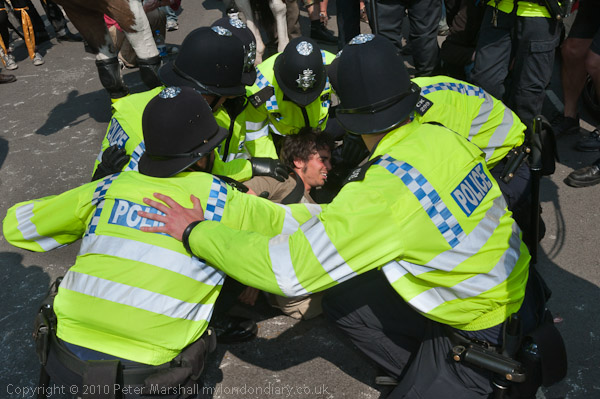
One of the eight arrests I saw, some at least of which seemed to be
rather random
more pictures
Around two hundred people took part in an early May Day Protest against the cuts, bankers, tax dodgers and those damaging the environment and the local community, which was met with confused policing with at least eight arrests, some at least of those who retaliated against attacks by police who appeared to lose control of themselves. Another was a young woman who refused to remove the scarf covering her face; another man was threatened with arrest for holding up his hands in front of the camera when an officer was photographing him at close range, but I'm not sure if he was actually arrested.
The meeting point on the promenade near the ruins of the West pier was a closely guarded secret, posted on Twitter, Facebook and on a mobile number half an hour before the event was to start. When I arrived there were around a dozen photographers and a couple of plain clothes police standing and watching roughly the same number of protesters, with a couple of police on horses around 50 yards along the prom and several police vehicles waiting on the road opposite.
By the time the march was ready to set off, all these numbers had swelled significantly and there were approaching a couple of hundred protesters. We were handed out a leaflet including a map of Brighton, marked with 27 suitable targets for protest, including arms manufacturers EDO MBM/ITT some way out in Moulscomb and Thales, several branches of Barclays, the UK's largest investor in the arms trade, an armed forces recruitment centre and Marks & Spencer's who support Israel by buying goods from illegal Israeli settlements. Other shops on the list included notable tax dodgers Vodaphone, Boots and the various Arcadia group brands - Topshop, BHS, Burton, Dorothy Perkins. Accused of damaging the environment were RBS who invest hugely in the area, Shell, particularly for their Rossport pipeline in Ireland, BP for their exploitation of tar sands, E.ON for coal fired power stations and Veolia. Other targets named included Brighton Town Hall, Tescos, Sainsburys and Starbucks, Fox & Sons involved in illegal evictions, Beyond Retro who sell fur and also two properties owned by the notorious Nicholas Van Hoogstraten.
The march started at 12.30 by throwing a giant dice which was used to determine the first target for the day. It came down as a 4, which meant we were going to Brighton Town Hall. The march formed up and set off in the right direction, but it never got there. As it started off, it was surrounded by police, with horses at front and at back and a row of officers along each side. There were a lot of arguments with police bringing the march to a halt at various points and it was hard to understand why. Finally in Duke Street the police kettled the protest. There were a few scuffles as protesters tried to push their way around the line of police and a couple of the protesters were arrested. One young woman was also apparently arrested for refusing to remove her mask for the police.
At one point, police formed a line and prevented shoppers and others from moving from Ship St into North St, although almost all the protesters were still in a kettle a hundred yards away in Duke St. One young couple with a child were a little disturbed, and I asked one of the mounted officers who was trying to clear the street to talk to the police forming the cordon and let them and others through as it was obviously a pointless restriction. The police fairly quickly realised this and began to let people through and out of the area.
After holding the protest there for 40 minutes, police came to an agreement with the marchers to allow them to continue, and they came out onto North street. Police then made them march along the pavement, and there really wasn't room for the police horses, particularly as some of the shops have overhanging signs. The march halted at the junction with East St, where several people used the megaphone to talk about the cuts and about the handouts to bankers - we were outside two banks including a branch of NatWest (owned by the RBS.) The marchers then moved up towards the pavilion gardens, with police horses galloping up past them. As I reached the narrow gates I heard one officer ask his neighbour "Are we supposed to stop them here?" and get the answer "I don't know", so they did anyway, although a dozen protesters had beat them to it, and the same number more vaulted over the locked wooden gates of the vehicle entrance before more officers formed a barrier in front of that. The rest of the march was then loosely kettled here again, and there were a few incidents that appeared to be provoked by police pushing back demonstrators who they felt were too close to them, and a couple more arrests were made.
After around 20 minutes or so, the officer in charge apparently managed to come to the decision that there was no reason why the protesters should not walk through the park, and they were allowed to do so, where they were cheered by a large crowd sitting on the grass eating and drinking.
For the next couple of hours the marchers ran and walked mainly in circles around the centre of Brighton, chased by police on foot and on horseback, who were left behind for some large stretches by sudden changes in direction. Occasionally their route was blocked by police, who also formed lines in front of some targets such as Boots and Tesco stores. On Queen's Road there were a group of football fans standing on the pavement outside the Royal Standard who jeered at the marchers, who retorted by shouting slogans against the EDL and the police were quick to make sure the two groups were kept well apart.
Eventually we made our way down to the promenade again and some of the protesters sat down briefly on the road. For once there was a clear message from the police and they were told they would be kettled unless they got up. They did, walking along the promenade for a while before running up the hill again (another arrest for no very clear reason) before going through Clarence Square and on to Western Road, then eventually going down Montpelier Road and back to the seafront. Here the protesters went down the steps and walked across the playground to the shingle beach. As we walked and ran around the town, most of the protesters and media had gradually drifted away, and there were only perhaps 50 of them left as they started to party there, watched from the promenade by slightly more police. I decided it was time too for me to leave.
I couldn't help feeling that both protesters and police would have benefited from rather more cooperation by both sides, and both need to make a greater effort to communicate with each other and with the public, many of whom were asking me what was going on.
I hope the Brighton police will learn from the event, not least that police horses are simply not suitable for the close escorting of protesters in narrow streets or on pavements. There are real health and safety issues here and mounted police need to be deployed more intelligently.
By the end of the day, officers in charge were clearly saying that it
was their job to enable peaceful protest - and seemed to be acting with
this in mind. But at the start of the protest they seemed to be far more
concerned with controlling and frustrating the protesters.
more pictures
Royal Wedding in Soho etc
Old Compton St, London. Friday 29 April 2011
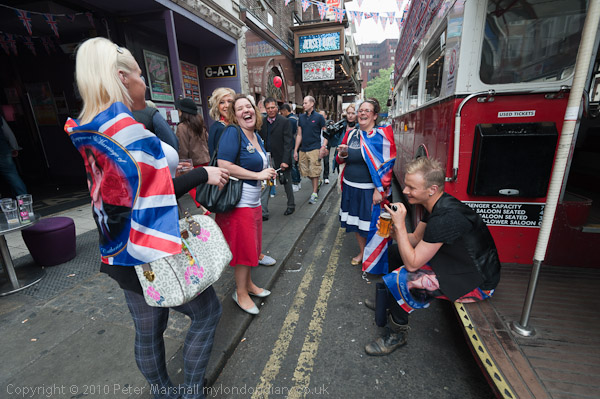
Waiting for the party to start
a few more pictures
I just took a few more pictures on my slightly rambling way (thanks to some street closures) back home. But I didn't want to wait for it really to get going.
Republic: Not the Royal Wedding Party
Red Lion Square, London. Friday 29 April 2011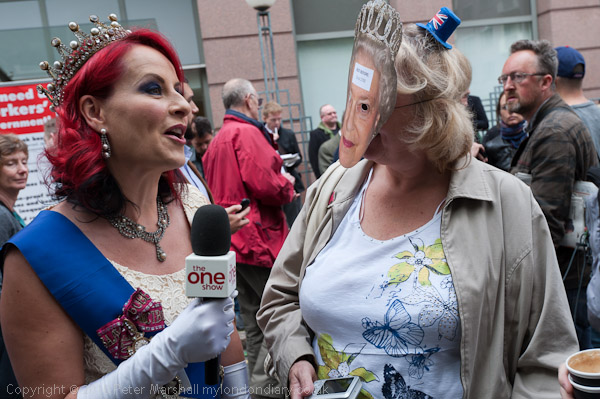 A TV presenter
from the one show talks to 'the Queen'
A TV presenter
from the one show talks to 'the Queen'
more pictures
Republic is a growing movement of people across the social and political spectrum who aim to address what they see as "the key flaw in British democracy" which "results from an unwritten constitution at the heart of which is the institution of the monarchy and the Crown." As their name says, they want Britain to become a republic.
The decided to hold an alternative street party on the day of the royal wedding, a small event for some of "Britain's 10 million republicans" but met with a great deal of opposition. Eventually they gained permission to have an event in Holborn's Red Lion Square. They state that their event was based on traditional street parties held to celebrate royal events, but with "one key difference - we'll be celebrating democracy and people-power rather than inherited privilege."
The first thing I noticed on arriving was a large card to congratulate Kate and William, with the message inside "While we wish you every happiness in married life, we oppose your right to inherit public office and will do all we can to ensure that the Queen's successor is chosen by - and accountable to - the British people.
There was a woman with a mask with the Queen's face, a BBC TV presenter dressed as a royal (I think it was Alex Jones and hope it was just a bad wig), lots of TV cameras, Peter Tatchell, and a few rather lost-looking members of the 'Love Police' whose leader had previously been taken into custody. Police had also prevented what would have been some amusing street theatre by arresting Chris Knight and a couple of his friends and confiscating their props including a small and not too convincing guillotine and some royal effigies.
There was food on sale, music, 'I'm not a Royal Wedding Mug' mugs and a bear who wants to be president when he grows up, and a stall was selling 'not royal' honours at cut prices; I turned down an offer to be a Duke, but I did get a blessing from the 'cardinal' as the Archbishop of Canterbury was otherwise engaged. There was even a man giving a short lecture to anyone who would listen about an alternative to the Union Flag, a tricolour of green, pale lilac and red which seems unlikely to catch on.
People were still arriving as I left, and slowly there did seem to be a
festive mood developing.
more pictures
Parliament Square Protests Continue
Parliament Square, London. Thursday 28 April 2011
Maria of the Peace Strike in Gitmo costume on one of her boxes (later
covered up for the wedding.)
more pictures
The resident protesters including Brian Haw's Peace Campaign and the Peace Strike are still in Parliament Square, enjoying the extra attention from crowds coming for tomorrow's royal wedding.
Maria Gallastegui was standing on top of her police box, wearing orange Guantanamo fatigues and a black hood, a reminder that their is still one Londoner, Shaker Aamer, a Muslim relief worker whose family are still living in Battersea, imprisoned in Guantanamo Bay, and that another man who spent his teenage years in Britain, Bradley Manning, is also in military detention in the US, accused as the Wikileaks whistle-blower.
Next door Brian Haw's Peace Campaign was still protesting, almost ten years after he started in June 2001, and his display seemed to have been smartened up a little for tomorrow's event. Although Brian is still in hospital in Germany, his colleague Barbara Tucker was there, telling inquiring members of the press that tomorrow was just another ordinary day so far as their protest was concerned.
Ms Tucker was in the High Court again yesterday, "turning herself in" for breaking a High Court injunction preventing her entering the currently fenced off public space of Parliament Square. She complains that the Mayor and police have set a new precedent by getting a High Court injunction to imprison people for peacefully challenging government policies in a public space.
Others making a protest there include Solomon Kumar Guntupalli, who has been on hunger strike there since 24 March, taking only plain water. He was arrested on 7 Oct 2004 and after 16 months on remand convicted and given an 8 year 6 months sentence for possession and conspiracy to supply cocaine.
He claims that he was tried without being able to see the evidence against him or to summon witnesses or cross examine prosecution witnesses, did not receive any hones or professional legal advice or representation and that there was conclusive evidence, including from CCTV that he was innocent. His hunger strike is for a full and thorough investigation into his wrongful arrest, conviction and sentence, and he has made a declaration that he intends to carry on his protest "Till Truth or Death".
While I talked to him this afternoon he was putting the finishing touches to a new poster for his display on the Parliament Square fence, especially for tomorrow, with Cupid's arrow through a heart giving the message 'Young Love is Beautiful Will -Kate.more pictures
International Workers Memorial Day
DWP, Caxton House, Westminster, London. Thursday 18 April 2011
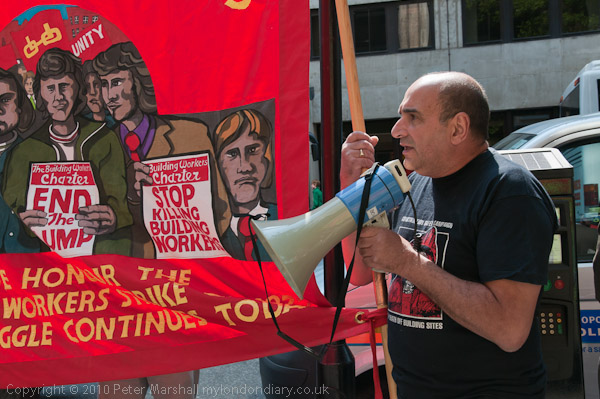
Justice for the Shrewsbury Pickets banner and Hazards Campaign speaker
more pictures
Events were held around the world today for International Workers Memorial Day, remembering those who have died in the workplace, with the slogan 'Remember the dead - fight for the living' including a protest outside the DWP against cuts in the Health& Safety Executive.
International Workers Memorial Day was established in Canada in 1984 and came to the UK in 1992, being recognised by the Scottish TUC in 1993, the TUC in 1999, and by both the Health and Safety Commission and the Heath and Safety Executive in 2000. The International Labour Organisation, part of the UN, recognised it in 2001, and today there were events in more than 50 countries in North America, Asia and Africa as well as Europe.
The TUC had organised a number of events, including a minutes silence in many workplaces at noon as well as protests, rallies and services. Among several events organised in London today was a lunchtime protest outside the offices of the Department of Work and Pensions at Caxton House in Westminster, which was particularly aimed at the drastic cuts being made by the coalition government in the UK Health & Safety Executive and Environmental Health Departments.
The protest was organised by the Construction Safety Campaign, which had also organised a wreath-laying at the statue of the unknown worker at Tower Hill earlier in the day. The construction industry is one of the most hazardous to workers, and deaths last year are thought to be up by 15%. Tony O'Brien, National Secretary of the Construction Safety Campaign, was in charge of the rally and was speaking when I arrived.
The government is cutting the Health & Safety Executive, already struggling to maintain a proper service, by 35%, and Minister Chris Grayling has recently announced that there will be an end to unannounced visits by HSE inspectors to a huge number of sites - including the whole of the public sector including health, education, local government, prisons and emergency services; public transport including buses and airports; the post office and parcels delivery; quarries; agriculture; manufacturing industries including light engineering, plastics, rubber, furniture, printing and paper.
The HSE figures for 2009-10 state that 152 workers died at work in the year, although as well as these, thousands of others died of work-related diseases including asbestos linked cancers. One of the speakers at the event, the Prospect union representative for London’s HSE inspectors, Simon Hester, told the rally that during one of his inspections the previous week he had found workers being exposed to dangerous levels of asbestos dust, a hazard not just to them, but when taken home on their clothes to their wives and children. With the decision by Grayling to stop such inspections, cases such as this will continue undetected in the future.
Minister Chris Grayling came out of Caxton House while the protest was taking place and was confronted by then protesters. He took one of the leaflets and said that he was always ready to meet officially with the unions, but refused to answer any of the questions he was asked when challenged by Tony O'Brien or Simon Hester, running off down the road. Grayling is Hester's boss, and the exchange is unlikely to further his job prospects.
Among the banners at the protest was one calling for justice for the Shrewsbury pickets, jailed for their trade union activities in the 1972 Building Worker's National Strike. The prosecution is viewed by many as a clear example of the undue influence that large construction companies - particularly in this case the McAlpine family - have over both government and judiciary, and there are also questions about the involvement of MI5 in the political conspiracy against the pickets.
Several of the speakers also mentioned the continuing illegal
black-listing of workers in the building industry for their trade union
activities, and in particular of workers who raise safety issues in
their union roles. Union safety reps have a critical role to play in
making workplaces safe, but if they try to take it seriously run the
risk of being blacklisted and unable to find employment anywhere in the
country in the building industry.
more pictures
Waiting For Will & Kate
Broad Sanctuary, Westminster, London. Thursday 28 April 2011
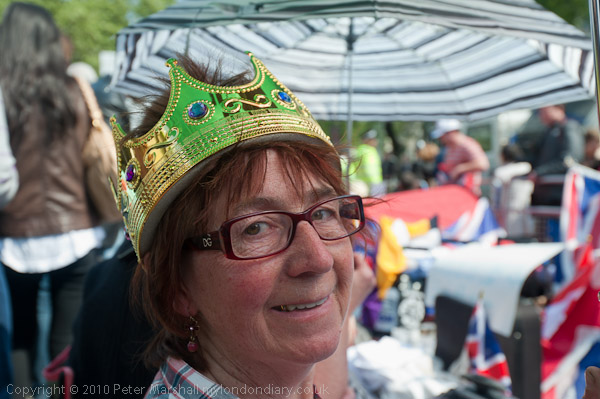 Waiting
for the wedding tomorrow
Waiting
for the wedding tomorrow
more pictures
Hundreds of people are camping on the side of the street opposite Westminster Abbey, waiting to watch the arrivals and departure from tomorrows ceremony. There is now a 'tent city' along the pavement of Broad Sanctuary opposite the Abbey, with many of those waiting sitting on folding chairs or the pavement. Most of them are dressed in some way for the occasion, with union flags and Kate and William souvenirs, and some had placards wishing the couple well.
Some waved other flags, including US, Canadian and a lone Ulster flag, and many had traveled a very long way to be here. Crowds of tourists and the media were filing past to watch and photograph them, and the police were bringing in new barriers to keep the people safe from the traffic still going past.
One or two commercial organisations were getting in on the act, with Ladbrookes offering odds on the colour of the Queen's hat and the name of the first dance.
24 hours before the event, the pavement was already getting full, and
smaller groups were gathering elsewhere on the route.
more pictures
More Thames Path
Charlton to Belvedere, London. Monday 25 April 2011
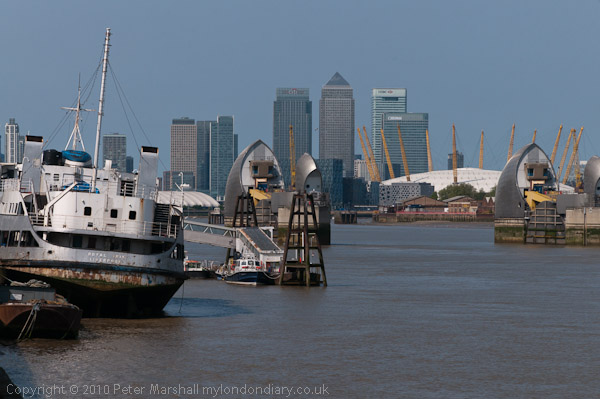
The view upriver from Charlton with the Thames barrier, Dome and
Canary Wharf
more pictures
This was a kind of walk, as I was with Linda & Sam who were walking, but I was on my Brompton, as my foot is still not entirely recovered and I can't walk as far (or as fast) as them and I wanted to come back earlier. But I did do a few extra bits, cycling down side streets and odd paths. Having the bike also saved me from having to keep running to catch up with them when I've stopped to take pictures, as they usually like to forge ahead.
We started at Charlton Station and joined the Thames path extension, walking to Woolwich, where we made a trip across on the ferry and after a very short visit to North Woolwich returned. I'd hoped to come back through the tunnel, but it is still closed.
The on along the Thames path past the former Woolwich Arsenal site and
Thamesmead (which I didn't detour to photograph) and then on to
Crossness, before I had to catch the train back from Belvedere, leaving
them to go on to Erith and then around by the Darent to Slade Green.
more pictures
Staines Moor
Staines Moor, Staines, Middx. Sunday 24 April 2011
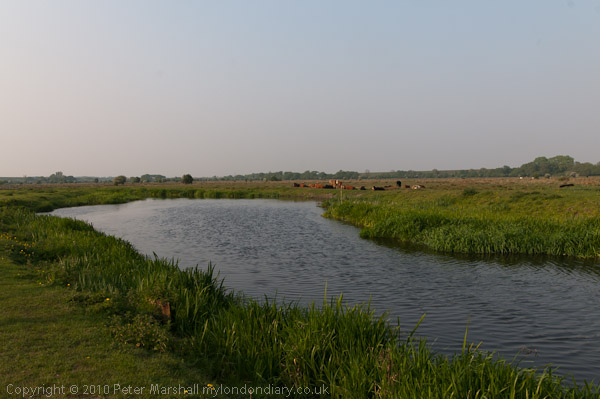
The River Colne on Staines Moor
more pictures
This Easter Sunday I didn't leap out of bed to go to the early morning service by the riverside, not quite at dawn, but at 7.30am, and I just turned over and went back to sleep. But later in the day I was persuaded to go out for a walk on Staines Moor, ancient common land a short walk from where I live.
I'm not a commoner, partly because the closest part of common land to my house did not get registered - and I don't think whosoever was living in this house at the right time could have claimed commoners rights. More recently the part opposite the end of my garden has been built on by the council. But in any case I wouldn't find the right to graze a horse and a cow for part of the year a great deal of use. Most of the commoners apparently felt the same and sold their rights to local farmers, who still make use of them, as people have done for a thousand years or so. Long enough to make this flat land around the River Colne a site of special scientific interest, although much of it has been disturbed after flooding a few years ago. It's now one of the few large areas of open ground in the area that has not been dug for gravel - though it is owned by a gravel company who have dug the area to the north - most of which, originally as dead flat as the moor, has been made into artificial hills of landfill.
We took the footpath up through the Moormede estate - built partly on the old lino factory sports field and past the small sluice that takes a little of the River Colne and makes it the River Ash, then through the tunnel under the bypass on to the path which runs close to the east bank of Bonehead Ditch. There is a thin, mainly wooded area here between the ditch - a small side-stream of the Colne and the western Staines reservoir that I spent a lot of time photographing when my children were very small.
The proper bridge over Bonehead Ditch is a mile or so to the north, but a couple of handily fallen (perhaps with a little help) trees make a bridges, and we gingerly make our way across them to the moor. We've had little rain for a while, and the moor is pretty dry and we are able to walk where we like rather than keeping to the various causeways, inches higher than the rest of the ground.
There is a circle of trees not far from the ditch, and we wonder why it was here, and clearly there were the remains of some fences around some of the trees. I photographed these years ago when the moor was frozen, its mud turned to solid ice and covered with snow, branches black against the white, and the fallen trees looking like some prehistoric monsters, but today it is all green and sunny and more a place for finding fairies.
We strike off across the moor in a straight line for the bridge across
the Colne to make our way back into town, past a small herd of horses
and cows, and, on the other side of the bridge, a few young bullocks.
Despite the row of pylons and their cables above us, and the constant
stream of planes to the north coming in to land at Heathrow, it is still
a good place to walk.
more pictures
Congolese Protest in London
Great Portland St to Downing St, Saturday 23 April 2011
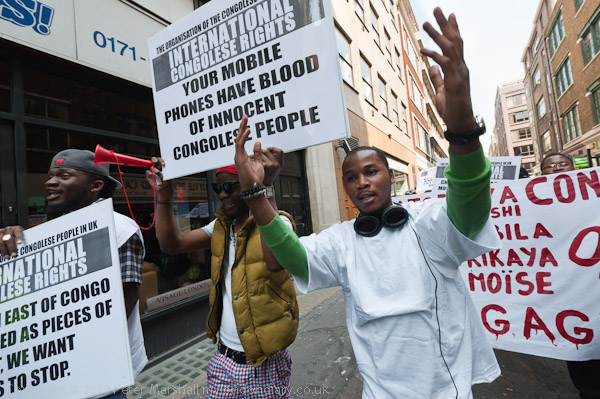
The marchers were singing and dancing while
carrying large, clear placards.
more pictures
The International Congolese Rights organisation marched from the Congolese Embassy in Great Portland Street to Downing St calling attention to human rights violation in the DRC and asking the UK Government to put pressure on President Kabila to hold elections or resign. London,UK 23/04/2011
International Congolese Rights (ICR) was formed in 2004 to defend the rights of Congolese citizens living in the UK, and has developed into a radical opposition to the current government of the Democratic Republic of Congo (DRC) and President Joseph Kabila. It has held a number of demonstrations aimed at exposing the systematic violation of human rights in the DRC aimed at getting the UK and the international community to take action.
The DRC (formerly known as Zaire and earlier as Belgian Congo) has been at the centre of African wars since the end of the era of direct colonial rule. The so-called African World War or Second Congo War was formally ended in 2003 but has continued in the east of the country.
The DRC has vast mineral resources, perhaps the the richest of any country in the world, including 80% of the world's cobalt reserves, and between 65-80% of coltan, the mineral from which tantalum capacitors, vital for mobile phones, games consoles, computers and other electronic devices. Coltan is generally considered to be the major factor behind the African conflicts.
Despite the huge wealth of natural resources, the people of the DRC remain some of the poorest in the world, while the country is judged to be amongst the most corrupt in the world. There have apparently been problems in previous years with visitors traveling to the country from the UK being refused entry as staff at the London embassy are alleged to have provided them with fake visas while selling off the genuine items on the black market
The protesters met outside the embassy of the DRC, now in Great Portland St, its metal shutters firmly rolled down, and their petition to the Prime Minister began with the demand that he order the embassy to be relocated as it is disrupting businesses in that area as it has no reception facilities for visitors.
They also appealed to the government "to bring pressure to bear on President Joseph Kabila to respect the constitutional obligations to hold the general election, otherwise to step down for a new political order." The petition was signed by the Chairman of the ICR, Albert Mukendi.
The protesters were a lively group of more than 50, but seemed rather more as they chanted, danced and sang on their way through the streets, behind a main banner reading 'David Cameron - Why Are So Quiet On 8 Million Deaths in D. R. Congo?' and the real message of the protest came from the many large placards they held, including several about resources:
- Your Mobile Phones Have Blood Of Innocent Congolese People
- We are suffering because of our Diamond and Coltan
But the majority of them were about the widespread use of rape as a military and political tactic:
- Congo Is Voted The World Capital For Women Rape
- Every 3 Minutes A Woman Is Being Raped In East Of Congo, We Want This To Stop.
- Children Young As 3 Months Old Are Being Raped In East Of Congo, We Want This To Stop.
- Women In East Of Congo Are Treated As Pieces Of Meat, We Want This To Stop.
- We Will Keep Fighting To Bring Justice For Those Women Raped In East Of Congo
As well as these about conditions in the Congo, there was also an expression of sympathy for the people of Japan, but the overall message was about the corrupt Kabila regime, and again the placards made this clear:
- The Congolese embassy is closed for business until Kabila steps down from the office.
- For The Sake Of Democracy In Congo Kabila Must Be Sent To International Criminal Court.
Recognise The Armenian Genocide
Oxford St to Downing St, Westminster. Saturday 23 April 2011
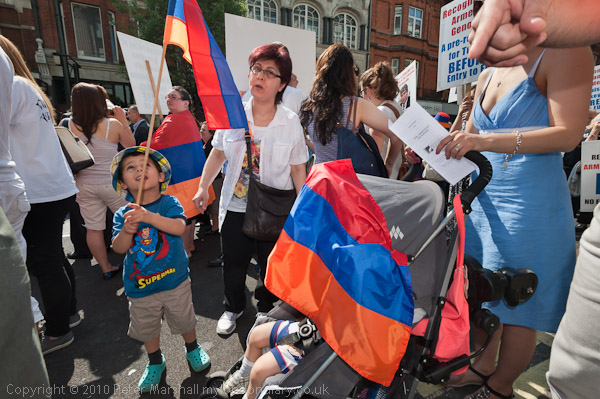
The Armenians had Superman on their team
more pictures
More than a thousand members of the Armenian community in the UK marched through London to Downing St, calling on the UK government to recognise the Turkish Genocide of Armenians in 1915.
On 24 April 1915 the Turkish authorities arrested around a thousand leading members of the Armenian community in the capital city of Constantinople (now Istanbul) and murdered them. They went on to disarm and kill around 300,000 Armenian men who had been conscripted into the Turkish Army. The next stage in the attempt to eliminate the Armenian people included, in the words of the Campaign for Recognition of the Armenian Genocide, "mass killings, deportations and death marches of women, children and elderly men into the Syrian Desert. During those marches, many of the weak or exhausted were killed or died. Women were raped. The deportees were deprived of food and water. Starvation and dehydration became commonplace."
Roughly 70% of the Armenian population - about 1.5 million were killed, mostly in 1915, although the massacres and deportations continued in 1916 and on a smaller scale until 1923.
The Armenians were in the way of the Turkish policy of creating a single homogeneous Turkish nation, having a strong national identity with their Christian heritage at its centre. The Turks, angered by the Armenian desire for independence, decided that the only solution was to get rid of them from the Turkish empire. The Turkish government still refuse to accept that their country had a policy of genocide, explaining the deaths as the result of a civil war. But the Armenians had no weapons or organisation to carry out any war.
When the UN was set up after the Second World War, one of its early resolutions was one on 'The Prevention and Punishment of the Crime of Genocide' and it was proposed by Raphael Lemkin who had coined the term genocide, describing it as "The sort of thing Hitler did to the Jews and the Turks did to the Armenians."
Although the UN Commission on Human Rights has described it as genocide and many countries around the world have recognised it in their parliaments, the UK has still to make such a declaration, and the main aim of this annual march is to persuade our government to officially recognise the Armenian genocide.
Armenians state that the "request for recognition is a moral issue that would restore truth and justice and lead toward reconciliation."
The marchers formed up on Oxford Street for the march to Downing St, led by male and female members of the Armenian scouts carrying an Armenian flag and a Union Jack and then a group of them carrying wreaths. Behind them were leaders of the Armenian community followed by a thousand or more people, some wearing or carrying Armenian flags, along with placards and banners.
The Armenians insist that Turkish recognition of the genocide should
be a pre-condition for Turkey to join the EU. Other placards called for
the Armenian genocide to be taught in the National Curriculum, and some
had a picture of Hrant Dink (1954-2007) 'The 1,500,001st
Victim of The Armenian Genocide', former editor of the Istanbul
Turkish-Armenian newspaper Agos, who was prosecuted under Article 301 of
the Turkish Penal Code which makes it a crime to publicly denigrate the
Turkish government, republic or nation. After having received many death
threats he was assassinated by a 17 year old Turkish Nationalist in
January 2007.
more pictures
St George's Day in London
Westminster, London. Saturday 23 April 2011

Celebrating St George in Trafalgar Square
more pictures
St George's Day was rather muted this year, displaced by the forthcoming royal wedding, with some St George's events actually having been rescheduled to take place after this. One that did go ahead on the actual date, and I watched just a little of it, was Cadet150, a parade by air, army and sea cadets from London which celebrated both St Georges Day and the 150 anniversary of these military youth organisations - though presumably the air cadets have not been going for quite as long, since the Royal Flying Corps was only founded in 1912 (and a few years later my father was keeping them flying when they became the RAF.) It wasn't an event that held my attention long.
Later I went to Trafalgar Square, where there were official
celebrations of St George's Day organised by London Mayor Boris Johnson.
Like most official London events in the square I've been to in the past
few years it seemed pretty hopeless, half-hearted with rather less
talent on display than the average village fete and none of the
participation that makes those events considerably more interesting. The
steps at the back of the square were fairly full with people sitting and
eating and drinking but most people seemed to be ignoring the
performance on the stage (relayed to them on a couple of large screens.)
There were a small handful who had dressed up and were having fun,
including what appeared to be a number of football supporters.
more pictures
Good Friday Procession in Staines
Staines, Middx. Friday 22 April 2011
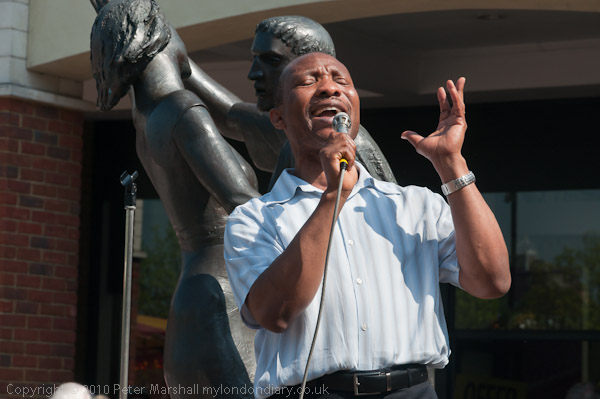
A sermon in the shopping centre
more pictures
Along with other Christians around the world, those from churches in the outer London suburb of Staines made a procession of witness through their town, holding a service in the shopping centre. Christians around the world are celebrating Easter this weekend, with the Western and Eastern Orthodox Easter, as occasionally happens despite their using different calendars, falling on the same date. So today was Good Friday or Holy Friday for both traditions.
In many villages, towns and cities across the world the day is marked by religious processions, usually led by a person carrying a cross in which Christians bear witness to their faith, and include a public act of religious worship.
Staines, on the western edge of London close to Heathrow airport has for some years had its own procession, an ecumenical event involving most of the local churches, and organised through the local council of churches. What happened here is probably fairly typical of the events in many towns and suburbs across the UK.
This is very much a local event, fairly typical of those that take place throughout this country. A largish crowd assembled outside the Methodist church near the Thames in the town centre and at around 11am. When the Salvation Army band arrived they formed into a procession behind it, with a few ministers and church leaders at its front, and led by two people carrying a wooden cross.
This then set off across the one-way system and along the fairly wide pavement to the pedestrianised High Street. Here there was a special market day (usually it is only Wednesdays and Saturdays) and the band had been worried about whether they would be able to march through, but there was no problem, with shoppers standing to one side to watch as the procession came through.
From the High Street it turned up into the Two Rivers shopping centre, a large open area mainly filled with a car park and large shops on three sides around it. At its entrance, next to a large area of outdoor tables with people drinking morning coffee, is a small circular artificial mound with a statue of two dancers, and here the procession ended with an hour long service, enlivened by some fine playing by the band, as well as some great singing by a young woman from one of the churches, aided on her second song by two others with strong voices and a guitar. These performances certainly made many of those passing stop and listen.
There were also bible readings and prayers and some short comments from various clergy as well as a clear and rousing sermon about Christ's crucifixion and that his promise of a more fulfilled life was still open to those prepared to accept it - just as it was to the robber being crucified alongside Jesus, who said to him "Lord, remember me when thou comest into thy kingdom" and received the reply: "Verily I say unto thee, Today shalt thou be with me in paradise.."
During the event, many of those passing by took free hot cross buns and leaflets being handed out by some of those taking part - and there were no buns left after the event, when everyone was invited to free tea or coffee back in the Methodist church, although there were still plenty of biscuits.
Staines is a place where very little happens - other than shopping -
and there is a real dearth of public events of any kind - and the local
authority seems to try to discourage any public life.
more pictures
Climate Rush Tate Britain Oil Spill Picnic
Tate Britain, London. Wednesday 20 April 2011
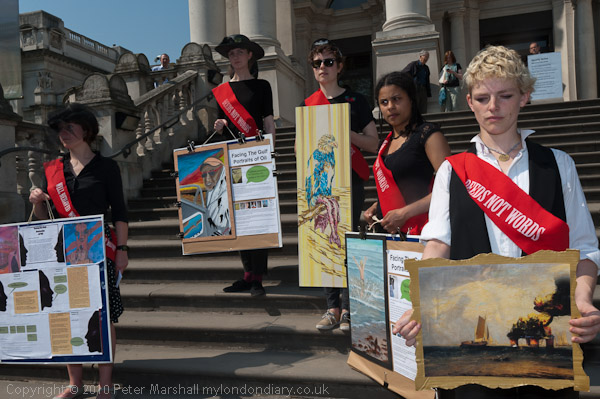
Art show from the Gulf along with a new Turner with flaming oil rig on
show at Tate Britain
more pictures
On the first anniversary of BP's Deepwater Horizon Oil disaster, Climate Rush held a party and art show protest outside Tate Britain where BP tries to clean up or 'greenwash' its image by art sponsorship. London, UK. 20/04/2011
A year ago, BP's Deepwater Horizon rig in the Gulf of Mexico began to gush oil at a huge rate from the deep sea bed into the Gulf of Mexico, contaminating a huge area of the ocean, ocean floor and coastline. 80% of that oil is still there, and BP's efforts to clean up the spill using gallon upon gallon of toxic dispersant (Corexit, banned in the UK) made matters worse. While reducing the largely cosmetic damage of oil floating on the surface of the sea, the dispersant breaks down the oil into small droplets which are then ingested by fish, shellfish and other species, greatly increasing the toxic effect of the spill.
Drilling had been allowed at great depth, where the hazards are not well understood and as was shown, the oil companies have great problems in dealing with them. What would have been relatively minor incident on land proved almost impossible to fix. Giant oil companies succeed in pushing through weak regulation which allows them to exploit unsafe areas thanks to their huge financial resources paying for high-powered lobbying.
As the Climate Rush protesters point out, disasters such as this oil spill are only a part of the environmental damage BP is causing to the planet. They are pressing ahead with their highly damaging and polluting extraction of oil from the Canadian Tar Sands, endangering the fragile Arctic environment - where disasters may have a dramatic impact on global warming - through drilling, and even plan to resume deep water operations in the Gulf of Mexico in a couple of months time. Of course BP is not the only environmental villain, with other oil companies also seriously threatening our future.
To rub salt into the Gulf coast wounds, the executives of Transocean Ltd, the company who were actually operating the Deepwater Horizon rig for BP, awarded themselves millions of dollars in bonuses last year to reward "the best year in safety performance in our company's history."
BP uses art and cultural sponsorship as a way of cleaning up its image and enhancing its reputation, so that people think of them as the people who sponsor great exhibitions and fine concerts rather than those responsible for huge damage to the environment. Until recently, the tobacco companies, selling products that killed millions who became addicted to them,used the same technique to gain respectability. They were kicked out of public institutions some years ago and the protesters say its time the same happened to the oil companies. And of course we are as a nation addicted to oil, and it is very much an addiction that is proving toxic for the world.
The Climate Rush protesters came to Tate Britain dressed in black to mourn those lost in the gulf oil disaster as well as the damage to the environment. They wore their normal red sashes, some with the suffragette 'Deeds Not Words' motto, and some too were in period dress recalling that heritage.
They brought with them an exhibition of paintings from the Facing The Gulf - Portraits of Oil project, produced in a 5 week project in in Grand Isle, Louisiana, a small community badly affected by the disaster, where UK artist Nick Viney spent 5 weeks teaching ordinary residents portrait painting. These portraits were then submitted for one of BP's largest 'greenwash' events, the BP portrait awards at the National Portrait Gallery, but were all rejected. They are now to be used to hold an alternative Portrait Award Ceremony outside the NPG on the night of the awards and then as a shadow exhibition following the pictures from the award when they go on tour.
These pictures were then held up by the Climate Rushers on the steps to the Tate Gallery, along with a 'newly discovered work by JMW Turner', his "Fishing upon the Blythe-Sand, Tide Setting with flaming Oil Rig', a smaller sketch of one of his images from 1809 currently on show at Tate Britain, and which the protesters intended to donate to the Tate Gallery and the nation at the end of their picnic. Fittingly Turner painted the original more or less at the site of BP's giant Coryton oil refinery on the Thames estuary, sold to Petroplus in 2007.
While some of the protesters stood holding these invaluable art works on the steps of the gallery, others handed out leaflets to those entering and leaving it, explaining why Tate Britain and other public institutions should not accept sponsorship from BP and the other oil companies.
The Climate Rushers went on to hold a picnic on the lawn outside the
gallery, handing out leaflets and sandwiches to those enjoying the warm
sunshine there - a very popular form of demonstration, although I don't
think anyone really ate the sandwiches which were garnished with 'crude
oil' poured from a teapot over them.
Then one of the protesters climbed up and put the Turner briefly on
display in one of the large niches along the front of the building,
which brought over the security who until now had watched benignly from
a distance, and the protesters promised not to do it again. The protest
continued at ground level with the exhibition, leafleting, sandwiches
and cake.
more pictures
Still In Parliament Square
Parliament Square, London. Tuesday 19 April 2011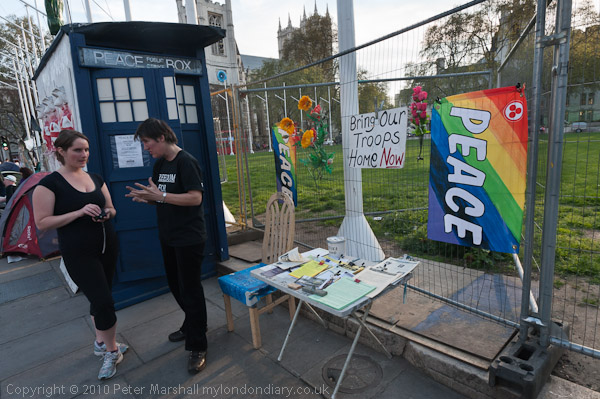
Maria Gallastegui talks to a visitor to her Parliament Square protest
more pictures
Despite statements made by David Cameron, Boris Johnson and others, the permanent protests are still in Parliament Square ten days before the royal wedding. Maria Gallastegui has offered to cover up at least some of her display for the event and has also been trying to get as many as possible art works in her area, hoping at some point to auction these off to raise money for a children's charity in Iraq.
Further along the pavement, past the 'Police Camp/Peace Camp' notice,
Brian Haw's protest, started nearly 10 years ago on 2 June 2001,
continues, although he is still in hospital in Germany and Barbara
Tucker along with another protester was arrested a few days earlier on a
charge of criminal damage for cutting the fence (she was later bailed)
and his display is unchanged. There are several other protests along the
pavement too. Everyone remembers the illegal removal of Brian's display
by police back in May 2006 and some have wondered if something similar
may be planned in the next few days.
more pictures
Stop Bombing Libya. Or Don't?
Downing St, Whitehall, London. Tuesday 19 April 2011
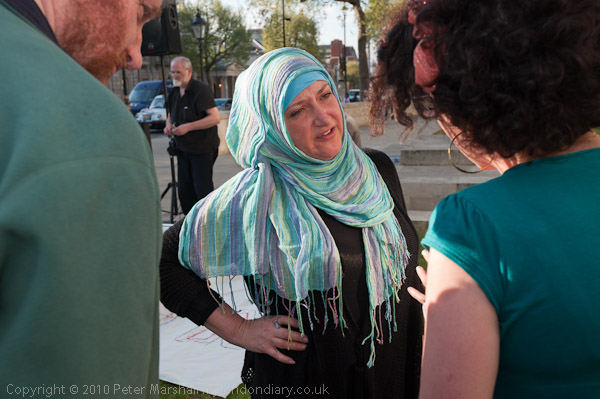
A Libyan woman argues with Stop the War supporters, asking why they
are supporting Gaddafi
more pictures
Stop the War held a protest at Downing St calling for the bombing of Libya to stop now. They were opposed by a small group of the Libyan opposition.
Around a hundred Stop the War supporter, including some Libyans, turned
up for the protest which was organised following last week's joint
statement by Cameron, Obama and Sarkozy which they say made
it clear that the aim of the NATO led bombing is now regime-change. They
point out this is neither sanctioned by the UN resolution nor legal
under international law.
After the protest had been going for around half an hour, a small group of the Libyan opposition turned up and set up a counter-protest around 50 yards along the road. They then started calling on Stop the War to join them in opposing Gaddafi and calling for an end to his regime, saying the the left in general and Stop the War in particular were supporting the wrong side in Libya by calling for an end to the NATO bombing.
One Libyan woman said that she had been in Benghazi when it seemed certain that it would fall to Gaddafi's forces, and that without the air attacks, she along with many thousands of others in that city would have been massacred as Gaddafi carried out his promise to deal with the 'rebels' street by street, alley by alley and house by house.
Neither group wants Libya to become another Iraq or Afghanistan, and would oppose anything that led to that kind of involvement by British and other foreign troops. But the Libyan opposition recognises their essential need for outside support in their fight against Gaddafi. They were enraged by seeing a couple of men in the Stop the War protest waving Gadaffi's monochrome green Libyan flag, and called on the Stop the War protesters to join them in calling for an end to the Gadaffi regime - but got no response.
Several people walked across at intervals from the Stop the War protest to discuss issues with the Libyans, but although these discussions were being conducted in a civil manner, each time after a short interval police came and insisted that the people return to their own area. It seemed an unnecessary restriction on a dialogue that seemed to be welcomed by both sides.
Although there obviously are great dangers in the escalation of the
attacks on Libya, and the Security Council Resolution 1973 clearly goes
beyond the original provisions of the UN Charter (which precluded the
use of armed force by the UN) there does seem to be an overriding fact
that the UN recognised and we were all reminded of by a giant banner,
some 20 ft by 8 ft, brought by the Libyan opposition. In crude lettering
it stated 'Libyans Need Protection.'
more pictures
Orange Parade in London
Westminster, London. 16 April 2011
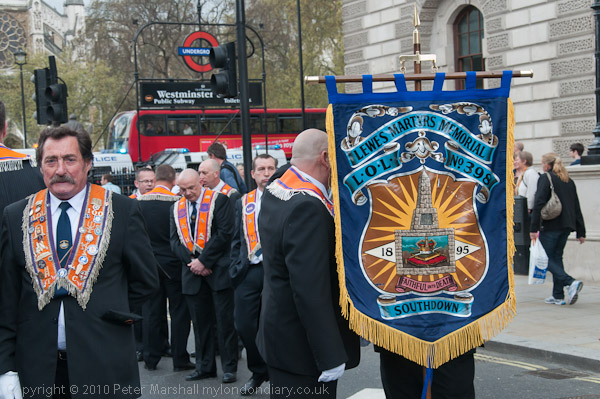
Orange marchers wait on Parliament St
more pictures
The City of London District Loyal Orange Lodge (L.O.L.) led their annual parade through London with lodges and bands from around the country taking part.
The Orange Order was founded in 1796 to uphold the Protestant religion, taking its name from King William III of Orange who ended the attempt by the Catholic James II to reclaim the British monarchy at the Battle of the Boyne in 1690. It was revived in the early twentieth century to oppose Home Rule for Ireland, and still plays a powerful role in Northern Ireland politics and government, embedded in Unionist politics.
As well as being firmly Protestant and upholding strongly traditional religious views, the structure of the organisation is very much along masonic lines, with Loyal Orange Lodges wherever there are significant Irish protestant communities.
Parades in Northern Ireland - there are roughly ten times as many Protestant parades as Catholic - are controversial, and have in the past often led to violent confrontations. Many Catholics see the parades as deliberately provocative, while many Orangemen regard the Parades Commission, set up to regulate these events as discriminating against them.
In London, the parades have little political significance and are a colourful celebration of the Irish Protestant tradition - membership of the lodges is restricted to Protestants. Many tourists stopped to watch and take photographs, though from the comments I heard some at least had little idea what the parade was about.
The parade formed up close to Tate Britain and marched up Millbank with the bands playing, going around Parliament Square and on to the Cenotaph, where it halted. Four wreaths were laid there, in memory of the fallen and former comrades, by the CIty of London Lodge, along with two lodges from Glasgow and the Maine Flute Band from Ballymena.
A group from the march then went into Downing Street to deliver a
letter for the Prime Minister, and the rest of the marchers stood
waiting for them. I left before they moved off to complete their parade
by the statue of the Duke of York in Waterloo Place, where they were to
lay further wreaths.
more pictures
Who Killed Smiley Culture?
Vauxhall to New Scotland Yard, London. Saturday 16 April 2011
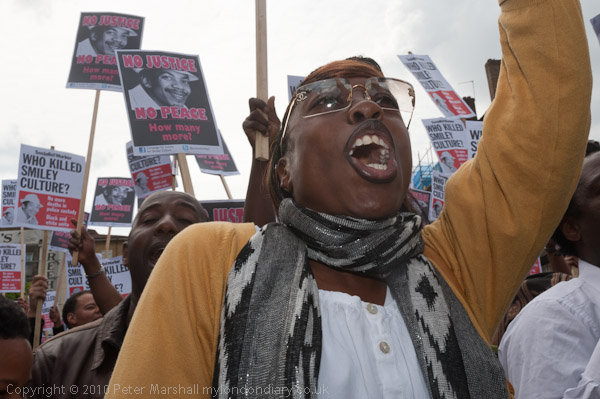
At the start of the march on Wandsworth Road
more pictures
Several thousand people, mostly black, marched through the streets of south London to a rally at New Scotland Yard in protest at the death during a police raid at his home on 15 March 2011 of reggae star Smiley Culture.
Four Metropolitan Police officers had called at his Surrey house around 7am and had searched the place and arrested him, apparently in relation to a drugs charge on which he was due to appear in court shortly. An hour and a half after their arrival, he is alleged to have been allowed to go into his kitchen alone to make a cup of tea, and to have killed himself with a single stab to the heart.
It sounds a most unlikely story - police would surely not have allowed a man they had arrested to go alone into his own kitchen, where apart from the possibility of escape they would also know there would be dangerous weapons. And killing oneself with a single stab wound to the heart is not an easy task. His family and friends are sure there was no reason why he should have wanted to commit suicide.
The case is under investigation by the Independent Police Complaints Commission, but the family complain that they have not been given any clear statement by police of what happened, and have made it clear that they will not rest until the full facts are known, and that justice has been done.
Deaths in police custody are unfortunately not rare, and according to Inquest, in the twenty one years since 1990 there have been a total of 930, with 247 of these in the Met area. Alongside these there have been 308 deaths occurring while suspects are being pursued, 109 in other road traffic incidents and 52 shootings.
Although a few high-profile cases hit the headlines - such as the shooting of Jean Charles Menezes and Harry Stanley, most others seldom make the national papers or even more than a short paragraph in the local press. Those that get most coverage have taken place in public, witnessed and sometimes filmed by members of the public, but most of them take place in the secrecy of the police station or other premises with police officers as the only witnesses.
Of course where there is a death there has to be an inquest, but too often these appear to be places where the truth is hidden rather than brought into the open. Police often fail to give evidence, or collude with each other to tell a false story. Of course not every one of those 930 deaths was suspicious, although a great many were, but we have yet to see even a single officer convicted of any offence concerning them - with the sole exception of the death of David Oluwale in 1969. It is more than hard to believe that justice is being done. And as the protesters chanted on the march, 'No Justice, No Peace.'
Other families whose sons and brothers had been killed by police were also taking part in the march, many wearing t-shirts with their dead relative's picture on them. Among the banners were those for Sean Rigg, killed by police in Brixton police station in August 2008, Julian Webster from Birmingham, killed by the bouncers on the door of a Manchester club in 2009, Kingsley Burrell, a man with no mental health issues who died last month in Birmingham after being sectioned and arrested under the Mental Health Act and Habib 'Paps' Ullah, who died during a stop and search in High Wycombe in 2008.
The march was held on the anniversary of the death of David Oluwale, killed in the first known incident of racist policing in 1969; his death remains the only case in British history that police officers have been found guilty of criminal offences leading to the death of a suspect, although they were found guilty only of assaults, the judge ordering the charge of manslaughter to be dropped.
Most of these suspicious cases of deaths involve healthy young black men - Smiley Culture at 48 was twice the age of most of them. There are white and Asian men who have died, and of course some women, but the great majority are men of African or Afro-Caribbean origin. But as speakers pointed out, this isn't an issue of racism but one simply of justice. Many years after the Stephen Lawrence case in 1993 led to the conclusion that the Met were institutionally racist, and action was promised to deal with this, the statistics still argue this is so, not just on deaths but in particular for stop and search, used so disproportionately against young black men that in some areas they regard it as a normal part of any night out.
The march, led by a lorry playing very loud reggae music started from the Wandsworth Road at 1pm and made its way slowly up through Vauxhall Cross and over Lambeth Bridge before going past the Houses of Parliament and on to New Scotland Yard for a rally in the street outside. Leading the march was Lee Jasper of BARAC along with members of the families of Smiley Culture, Julian Webster and the others who have died.
The crowd on the march - hundreds according to some reports, but
actually around two thousand or more - were in no doubt about who did
it. To a shout of "Who killed Smiley Culture?" the reply came
back loud and clear in unison from those several thousand throats "Police
killed Smiley Culture!"
more pictures
Westminster Council Be Ashamed
Westminster City Hall, Victoria St, London, UK. 14/04/2011
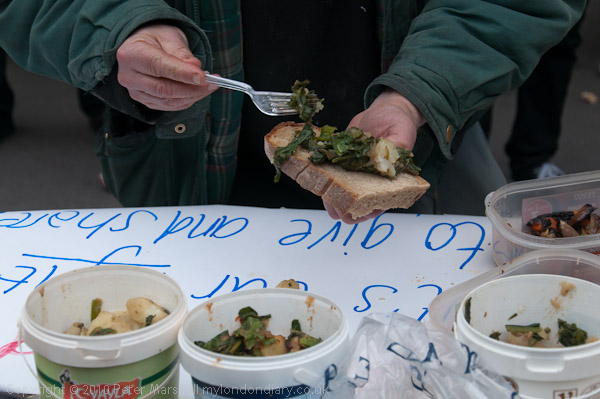
Giving food away like this will be an offence in Westminster
more pictures
Westminster Council intend to make it illegal to sleep on the streets of their city or to hand out free food to anyone, both punishable by fines of up to £500. They have also welcomed the proposed changes in housing benefit which will make many current Westminster residents homeless. For years the council have been carrying out a policy of economic cleansing aimed at getting rid of the less well off from their borough, exporting them to outer London (including some to close to where I live.)
As a part of the third National Day of Protest Against Benefit Cuts, claimants groups organised a protest including giving away of free food at Westminster City Hall. Unfortunately although the protest was intended to be from 5-7pm, the group which was going to come with the supply of hot food it regularly supplies for rough sleepers in the area was not expected to arrive until 8pm, and I had gone by then.
Some charities which support the homeless also oppose the "soup runs",
but most of them also feel that Westminster should be doing more to
support the homeless rather than simply enacting penal measures such as
these.
more pictures
Libyans Keep Up Their Protests
Downing St, London, UK. 14/04/2011
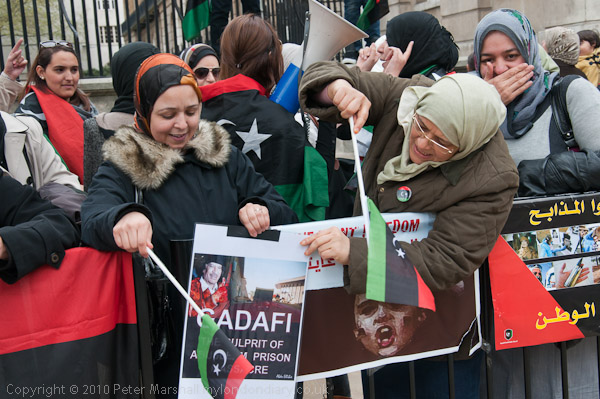
Women beat a picture of Gadafi with the Libyan revolutionary flag.
more pictures
Libyan women and children came to demonstrate opposite Downing Street calling for more action to save the people of Libya from the attacks by Gaddafi's military forces.
Unfortunately I had been told that the protest would start at 4pm when
in fact it finished at that time, so I was only able to photograph it
for a few minutes, after which everyone packed up and left. Many of them
were walking to continue their protest with the small group of
protesters already opposite the Libyan embassy. Protests are continuing
there every day, although numbers are greater on Sundays than during the
week.
more pictures
Claimants tell Daily Mail "Stop the lies!"
Kensington, London, UK. 14/04/2011
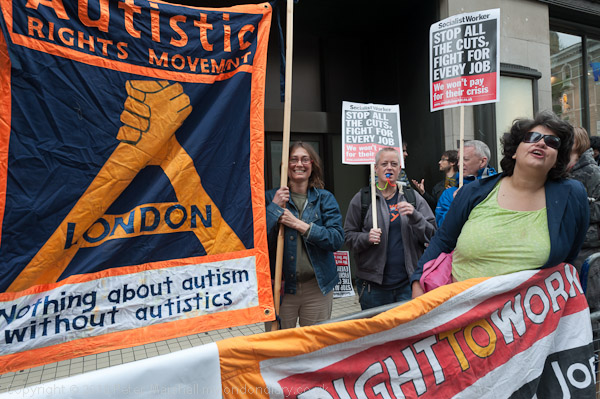
The Autistic Rights Movement and Right to Work
were among those supporting the protest
more pictures
Disabled people, single parents, unemployed, carers, those on low wages and others joined in a protest at the Daily Mail offices, outraged at the stream of lies and defamation against them that are printed by this newspaper.
The protest was called by networks of claimants' groups including Disabled People Against Cuts and is the third day of coordinated actions around the UK, with protests taking place today in 12 cities, as well as an online action by the "Armchair Army" of those unable to travel.
The main cause of these protests is the increasing drive to move claimants off of incapacity benefit by paying private companies such as Atos international to carry out quasi-medical tests - condemned by the CAB as "not fit for purpose" and heavily criticised in a report commissioned by the government.
These tests are poorly administered, often by people with inadequate training and insufficient time to carry them out, and many have been shown to incorrectly report the claimants responses to the questions and to use answers given by them in an inappropriate way. One in four of these assessments are appealed, and over 70% of these appeals are upheld. But even those who are successful on appeal have found similar mistakes being made in their next assessment.
These people, the most in need in our society, have been targeted by the government as an easy option, with a climate of public opinion against "benefit scroungers" being whipped up by lazy and inaccurate and misleading reporting, particularly by the Daily Mail, which also angers many other journalists as bringing the press into disrepute.
Linda Burnip from Disabled People Against Cuts said:
"The lies and half truths that the Daily Mail has published have resulted in an increase in hate crime attacks against disable people. We are not prepared to sit back and allow them to continue to peddle their disgusting disablist propaganda unchallenged."Martin Campbell from the London Coalition Against Poverty stated:
"The Daily Mail needs to know the disgust and anger its fear-mongering lies provoke. All those who experience the stress, insecurity, illness and sometimes destitution that result from Atos Origins's disastrous computerised "medical assessment" have a clear message for the Mail: Stop the lies! Stop the Defamation!"
more pictures
NUJ/Al Jazeera Demand Release of Journalists in Libya
Libyan Embassy, Knightsbridge, London, UK. 14/04/2011
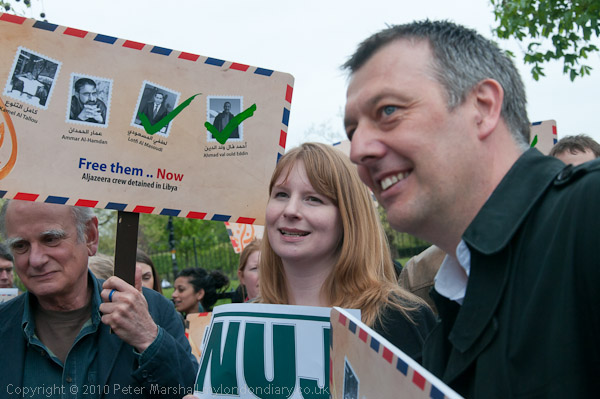
NUJ photographer, General Secretary elect Michelle Stanistreet and
General Secretary Jeremy Dear
more pictures
The NUJ and Al Jazeera held a protest opposite the Libyan Embassy calling for the immediate release of the two Al Jazeera journalists arrested in Libya last month and still held by the Gaddafi regime.
Both the outgoing NUJ General Secretary Jeremy Dear and Michelle Stanistreet who replaces him on July 1 were in the demonstration, along with other journalists including those from Al Jazeera, of whom at least who has recently been photographing in Libya.
They called for the release of the two cameramen Ammar Al-Hamdan and Kamel Al Tallou who were in a group of four Al Jazeera journalists arrested near Zintan in northwest Libya last month. The four were apparently released in Tripoli and then immediately rearrested on March 31, and two have since been released.
Ammar Al-Hamdan is a Norwegian of Palestinian origin who was born and grew up in Baghdad. Married to a Norwegian journalist, since 2006 he has worked for Al Jazeera in Oslo since 2006.
The day after the protest news has came from Al Jazeeera that Kamel Al
Tallou, a UK citizen who worked as a doctor in England before becoming a
journalist has now been released.
more pictures
Freedom Umbrella Kurds March Through London
Old Marylebone Rd - Downing St, London. Sat 9 April 2011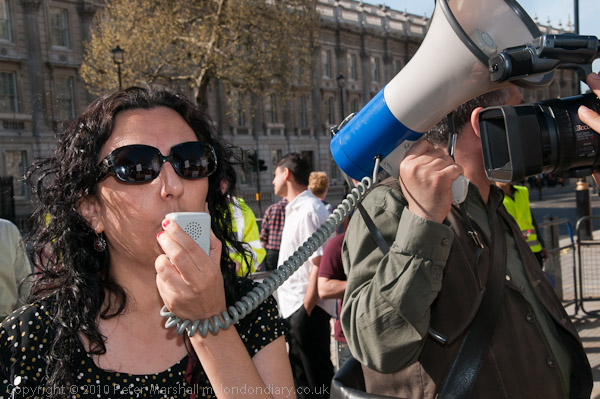
Speaking opposite Downing St
more pictures
Several hundred Kurdish activists marched through London to a rally at Downing St calling for support of the people's uprising for freedom and social justice in Iraqi Kurdistan.
Freedom Umbrella (Chatri Azadi) is a coalition of British-based Kurdish organisations and supporters and it organised a demonstration in front of the offices of the Kurdistan Regional Government in Old Marylebone Road followed by a march to a rally opposite Downing St.
Little has been heard in UK media about the people's uprising in Iraqi Kurdistan, which started on 17 February in Sulaymania and has since spread to other towns and cities in the area, except for Gerbil and Duhok, where President Massoud Barzani, the leader of the Kurdistan Democratic Party (KDP) can use his security police to exercise strict control and prevent any protests.
Iraqi Kurdistan is dominated by two political groups, the KDP and Jalal Talabani's Patriotic Union of Kurdistan (PUK), each with its own army, and both essentially the private militia of their ruling family. These militia were supported by the US as a part of the fight against Saddam Hussein - and their continuing corrupt and despotic rule is the legacy of the first 'no-fly' zone imposed by the US, UK and France over northern Iraq in 1992.
Both the PUK and the KDP have abused human rights, with thousands of people being killed or disappeared, and have imprisoned political opponents and intellectual, and targeted independent journalists and publications. Both too have amassed fortunes for their ruling families through force and corruption, while few Iraqi Kurds even have access to clean water and electricity - and health, education and welfare services are virtually non-existent.
As in many other countries in the Middle East, the people of Kurdish Iraq have been protesting on the streets for freedom and justice, but their protests and the brutal repression of them by the Kurdish Regional Government have received relatively little attention in the western press. The KDP and PUK militias have opened fire on peaceful protests, arrested, kidnapped and killed demonstrators. There have been at least nine deaths, including those of 12 and 14 year-olds, and more than 200 people with serious injuries.
The protesters wanted to make the British public aware of what is
happening to the Kurdish people in Iraq and to show international
solidarity with them, They also called for the UK government to end its
support for the Kurdish militias in Iraq.
more pictures
Ugandans Demand Democracy
Uganda House, Trafalgar Square, London. Sat 9 April 2011
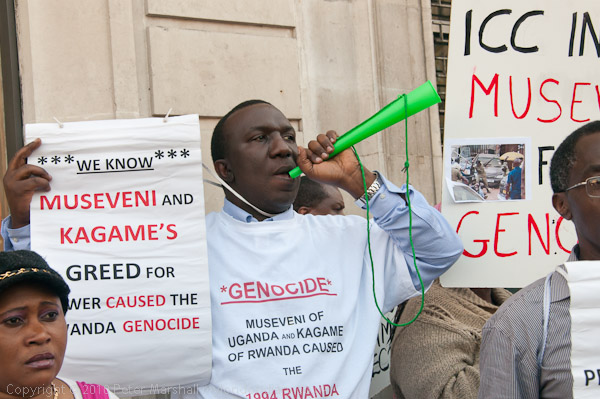
Although the protest was called about the elections, most of the
placards were about the Rwanda Genocide
more pictures
Ugandans living in the UK protested outside Uganda House in Trafalgar Square, calling for new free and fair elections after the rigged Parliamentary and Presidential elections in February.
Uganda held a General election on 18 Feb, which resulted in the sitting president, ex-guerilla commander Yoweri Museveni of the National Resistance Movement who has held the office for 25 years being elected for another term with 68% of the votes in an election in which around 59% of the 14 million eligible voters took part.
His nearest rival, Kizza Besigye of the Forum for Democractic change polled 26% of the vote with no other candidate getting more than 2%.
A 120 member EU Election Observation Mission had been in Uganda for a month before the vote, along with a four person delegation from the European Parliament, and they issued a preliminary report shortly after the election, with a final report to be made in May.
Their preliminary report stated that the election "was marred by avoidable administrative and logistical failures which led to an unacceptable number of Ugandan citizens being disenfranchised" and they also said that Museveni had exercised his powers as president to "such an extent as to compromise severely the level playing filed between the competing candidates and political parties."
In particular they note that the state owned Uganda Broadcasting Corporation (UBC), failed to comply with its legal obligations to treat each presidential and parliamentary candidate equally, with its television channel giving the incumbent president and the ruling NRM party substantially more coverage than their nearest rivals.
Amnesty International published a detailed report on the Human Rights abuses in Uganda in the period leading up to the election, including a failure by the police to take action against groups attacking opposition political meetings, intimidation and assaults on journalists and the cancellation of broadcasts.
A small group of protesters with placards filled the frontage of Uganda
House in the south-west corner of Trafalgar Square, nosily shouting
their demands. They want a free and fair re-run of the elections without
the massive vote-rigging they allege occurred, the appointment of a new
non-partisan and independent Electoral Commission, a new 'clean' voters
register and new voters cards. They also called for an end to the use of
the Armed Forces rather than the police to provide security, for equal
opportunity to be give to all candidates and for the education of
voters.
more pictures
Vaisakhi Celebrations in Woolwich
Ramgarhia Association Gurdwara, Woolwich. Sat 9 April 2011
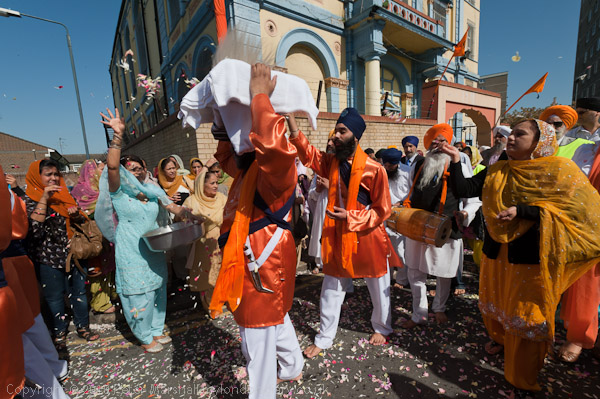
People throw flower petals as the Guru Granth
Sahib is carried out for the procession
more pictures
Sikhs from Woolwich's two Gurdwaras took part in a Vaisakhi procession through the centre of the town, celebrating the creation of the Khalsa in 1699.
Sikhs around the world celebrate Vaisakhi on the 14th April, but events marking it are held throughout the month in various towns and cities. The celebrations in many places include a religious procession (Vaisakhi Nagar Kirtan) through the town.
The two Woolwich Sikh temples take turns to be the starting point of the procession, and this year it was starting from the Ramgarhia Association Gurdwara in Mason's Hill to the east of the town centre and making its way to the Gurdwara Sahib Woolwich in Calderwood Street in the middle of the town. The Ramgarhia Sikh community had its origins close to Amritsar in the Punjab, and were renowned for their military prowess and the victories of the armies.
The Vaisakhi festival, which takes place on April 14 each year marks the formation of the Khalsa by Guru Gobind Singh, the tenth Sikh Guru, in 1699. Sword in hand he called upon the assembly of Sikhs, asking who was willing to give his head for the sake of his faith. One brave man stood up and went with him into a nearby tent; shortly the guru returned, his sword now dripping blood and repeated the call. Again a man stepped forward, and three more times the guru made the call before he finally returned to the crowd - but this time he was is time hand in hand with the five "beloved ones" who had been willing to die for their faith and who the crowd had thought dead - still alive and dressed in saffron robes and turbans. These "Panj Piare" were the first Khalsa - baptised Sikhs - and their baptism was marked by drinking Amrit, sugar stirred with water in an iron bowl with a khanda (double-edged sword) by the Guru as he recited sacred verses.
Guru Gobind Singh, the tenth guru, was the last living guru, and gave Sikhism its modern form. He established the five Sikh symbols - the five K's - of Kesh (unshorn hair), Kangha (wooden comb), Kara (iron bracelet), Kirpan (dagger) and Kachera (underwear) and gave all male Sikhs the name Singh (Lion) and females the name Kaur (Princess.) But most radically he declared that his successor as guru was to be the Guru Granth Sahib, the holy book of the Sikhs and now their eternal guru.
I arrived early for the procession, and after having been welcomed was given a Sikh headscarf to wear and taken to the community eating hall or langar, where I enjoyed some of the free vegetarian food on offer to all, prepared and served by members of the congregation who volunteer their services as a part of their religious practice. Unlike some other gurdwaras, most of those eating here sat on chairs at tables to eat, rather than on the floor, although there was a carpet along the far end for those who preferred that more traditional practice. After eating I was able to talk to some of the people there before wandering around the gurdwara taking photographs.
The Ramgarhia Association converted an existing landmark into a Sikh temple in 1970, and it is flourishing - they have great plans to expand on show on the langar wall. Built as the Freemason's Hall around a hundred years before they acquired it, is actually a few yards east of the Woolwich boundary in Plumstead. The name of the road it is in, Mason's Hill, gives a clue to its former use, although this street was formerly known as Mount Pleasant. The building, which is now considerably more colourful and has a tall Nishan Sahib (a saffron fabric covered flagpole with a Sikh symbol at its peak) at one corner occupies a little-known but important place in the history of football, as it was here that the Royal Arsenal Football Club held its annual meetings and dinners - and on 16 May 1891 that the Annual General Meeting of the Royal Arsenal Football Club was informed of the committee's decision two weeks earlier to turn professional - and on which account it had resigned from the amateur Kent and London Associations in which it had previously played. Still on its outside wall, although now largely unreadable is a ''Roll of Honour' for members of the Woolwich social club from here who fought in the First World War.
The Mayor of Greenwich, Cllr Barbara Barwick, arrived around 1pm, and I followed her into the worship hall, having taken off my shoes, and there we listened to the three musicians playing while people came in to show respect to the Guru Granth Sahib which was on an elaborate palki (throne) at the front of the hall.
Twelve Khalsa dressed in saffron robes and turbans then entered, and having bowed to the Guru sat cross-legged on the floor with the rest of the congregation, and there was some recitation and standing prayers. They were then presented with garlands of flowers and saffon sashes, and five were given swords as the Panj Piare, and another five were given Sikh flags to carry.
A small procession then came down from the upper worship room, including the remaining two Khalsa, one carrying the Guru Granth Sahib on a cushion on top of his head, and the other following behind it with a sacred whisk, and joined behind the Panj Piare as led by the standard bearers and followed by a small group of musicians they made their way out of the Gurdwara to the float that had been prepared outside to carry the Guru Granth Sahib in the procession.
Waiting outside the Gurdwara were a large crowd of worshippers who threw handfuls of flower petals over the Khalsa and the Guru as they made their way to the float that would carry the Guru in the procession. Also waiting were several open lorries in which the older women were taking part as well as the huge war drum (Nagara) mounted on top of a vehicle that would lead the procession.
Unfortunately there had been one or two holdups, and things were
running more than half an hour late and I had to run to catch a train
before the actual start of the colourful procession, with its joyful
singing of Sikh hymns, martial arts demonstrations and Dhol drumming
through the town, expected to take several hours.
more pictures
Englefield Green & Runnemede Walk
Surrey, Monday 4 April 2011
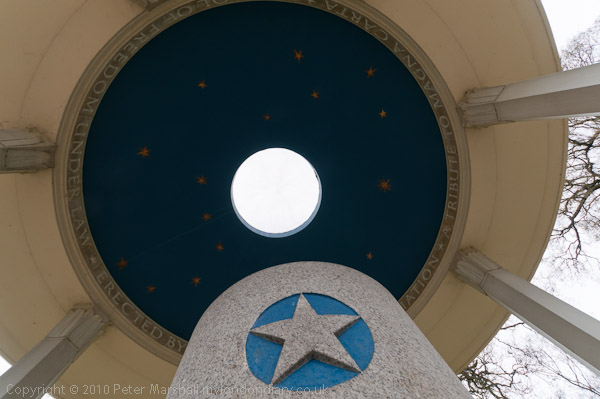
The American Bar tribute to Magna Carta at Runnemede
more pictures
It took almost half an hour on the bus to get to Englefield Green, held up by the two level crossings on the route. If the Airtrack proposals for a rail service from the west into Heathrow go ahead as proposed without replacing these with bridges it would virtually close down the road system in this area. I think it could even lead to direct action to block the lines, even in this deeply conservative area.
This was a pub walk, but we started at the former Methodist church, now open as a Chistian centre with a café in the centre of the village, which was convenient and cheap and the coffee wasn't bad. A short walk along road and footpath took us to Coopers Hill, and we walked down on the path through the nature reserve to Runnemede, where we went in to the Magna Carta Memorial and then along and up the hill to America, the one acre given to the United States in memory of John F Kennedy. So perhaps it qualifies as the 51st state?
It wasn't far to the pub, which turned out to be a disappointment. Although the Barley Mow looks the part and looks out on a large village green, neither the beer nor the food impressed me. The food was average pub standard but pricier and smaller portions, and the beer wasn't well kept. I'd been told there was a good range of beers but again found it disappointing. Friendly staff aren't enough to make me want to go there again.
The last fatal duel to be fought in England happened on the green here,
and the loser was brought into the pub and died. The unkind would say it
was probably waiting to be served.
more pictures
Shortwood Common & the River Ash
Staines, Middx. Sunday 3 April 2011
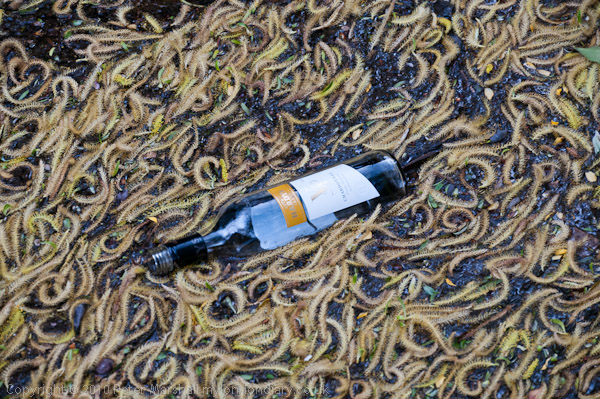
Suburban Spring
more pictures
It was a fine day on Sunday and I went out for a short walk after having been stuck in front of a computer most of the day. Staines isn't the most scenic of places, but it is mostly surrounded by water, rivers including the Thames, Colne (and several minor streams which connect or once connected to the Colne) and a number of fairly massive reservoirs, along with the odd unfilled gravel pit. Much of the remaining land that hasn't yet been built on is common land, with the largest area to the north of the town being Staines Moor. To the east is the remains of Shortwood Common, cut to pieces by the railway in the nineteenth century and the first section of the bypass, Staines Road West. Through it too runs an aqueduct linking some of the reservoirs, as well as the River Ash, and there are allotments, and on its edge is now a women's prison.
Usually we just walk across one remaining part of the common to get to a larger area over the railway and under the bypass, but this time we decided to wander around it, making our way to the outskirts of Ashford before turning back home.
The River Ash is not a huge stream, although it has appeared in some major films, standing in for rather larger rivers, as a mile or two further on it flows through the grounds of Shepperton Studios. I don't know its history, but guess it is probably a medeival construct built to power a mill or mills, taking water from the River Colne just above Staines (a small sluice next to the later part of the bypass), and running around the east of Staines - it might like another small Staines waterway, Sweeps Ditch which runs along the bottom of my garden have been a boundary ditch - and running along the western edge of this part of the common.
When the built the reservoirs aqueduct, the Ash presented a small problem as it crosses its path on the Ashford boundary. The Ash disappears into a grid, from which it dives down under the aqueduct and then comes up on the other side.
We made our way back past the remains of one of Staines last farms,
next to a house which appears to be left deliberately derelict. It's a
fairly grand house for the area, and has been empty since its last
owner, who owned a shop on the High St, died. The site it is on includes
the old farmyard and would be worth considerably more if planning
permission could be obtained for the whole site - and perhaps some
extreme vandalism might help. Opposite is one of Staines's more ugly
recent developments, a block of flats where we used to take our boys to
look at the chickens running free in the orchard.
more pictures
Feathers Fly in Trafalgar Square Pillow Fight
Trafalgar Square, London. Saturday 2 April 2011
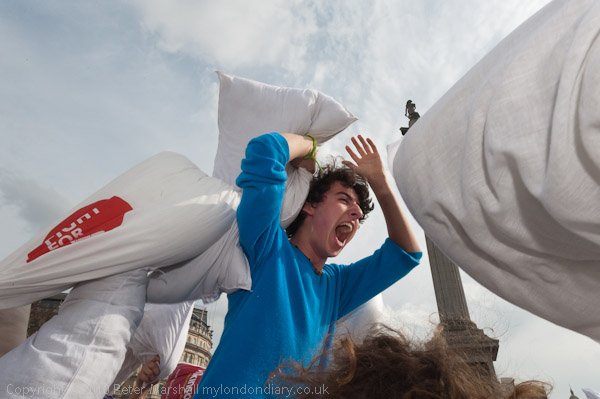 Taking
part in a pillow fight in Trafalgar Square
Taking
part in a pillow fight in Trafalgar Square
more pictures
Several hundred people took part in a half hour pillow fight in Trafalgar Square, part of the urban playground movement and one of 150 pillow fights in cities around the world today in some kind of world record attempt.
The urban playground movement which coordinated the event is the fun end of a wider public space movement, which aims to consciously celebrate public space in cities and to get the public participating in events in them. They hope to partially replace "passive, non-social consumption experiences like watching television" with social and communal activities in our "urban living rooms."
It was interesting to see this taking place in Trafalgar Square, which the Mayor of London treats as a private place, with "Heritage Wardens" preventing many activities - such as unapproved demonstrations and at times photography - there. Many of us are greatly concerned at the increased privatisation of public space in our cities.
Presumably the organisers of the pillow fight had obtained permission to use this particular "living room" today, as the heritage wardens stood watching and smiling.
Pillows were being sold to people who had not brought their own, with all takings going to the Japan Tsunami Appeal. There was also an after-party as a part of the event with proceeds going to the same charity.
The event had a number of sensible rules, although some were not entirely followed by everyone - such as not bringing feather pillows - much to the delight of photographers. And although I did get hit quite frequently, at least most of those who broke that particular rule did so by accident and apologised. But it does mean I can confirm that everyone seemed to follow the injunction to use soft pillows.
The event started with a signal at 3pm when people converged into a heaving group in the centre of the centre of the square and began swinging their pillows with abandon. Perhaps the rule most often broken was to swing lightly, as at times things got fairly hectic.
It was however an incredibly good-natured fun event, although by the
end of the half hour, many were exhausted and laid down on the square
with their heads on their pillows.
more pictures
Queens Terrace Café
Queens Terrace, Swiss Cottage. Saturday 2 April 2011
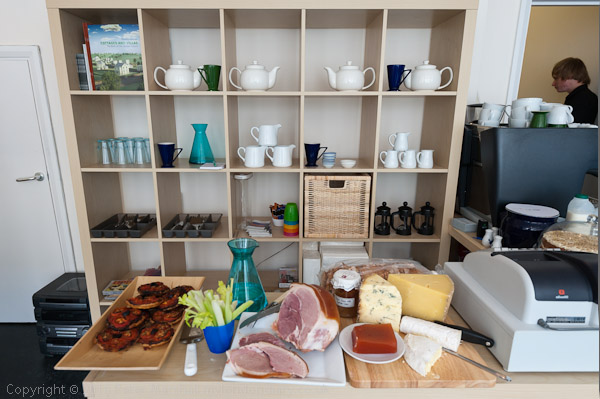
The café counter with some of the fine fresh food
the cafe specialises in.
more pictures on >Re:PHOTO
It isn't every day one of my friends opens a café, and this one in
Swiss Cottage is no ordinary café but a cultural café. At top left on
the shelves is book by Mireille Galinou whose café this is, a study of
St John's Wood showing it as an early example of a garden village which
was published last year by the Yale University Press. More on this café,
together with more pictures on
>Re:PHOTO
top of page
All pictures on this section of the site are Copyright © Peter Marshall 2011; to buy prints or for permission to reproduce pictures or to comment on this site, or for any other questions, contact me.

